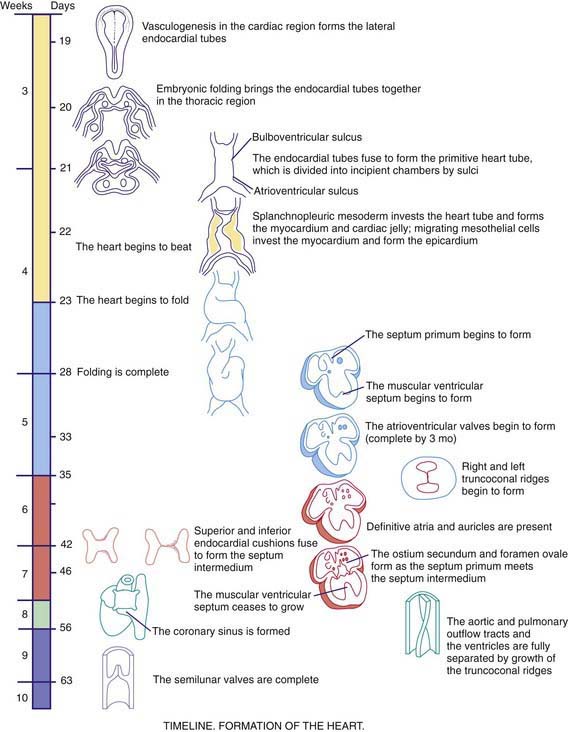Chapter 414 Cardiac Development
Knowledge of the cellular and molecular mechanisms of cardiac development is necessary in understanding congenital heart defects and will be even more important in developing strategies for prevention, whether cell or molecular therapies or fetal cardiac interventional procedures. Cardiac defects have traditionally been grouped by common morphologic patterns: for example, abnormalities of the outflow tracts (conotruncal lesions such as tetralogy of Fallot and truncus arteriosus) and abnormalities of atrioventricular septation (primum atrial septal defect, complete atrioventricular canal defect). These morphologic categories may be revised or eventually supplanted by new categories as our understanding of the genetic basis of congenital heart disease progresses.
414.1 Early Cardiac Morphogenesis
In the early presomite embryo, the 1st identifiable cardiac progenitor cell clusters are arranged in the anterior lateral plate mesoderm on both sides of the embryo’s central axis; these clusters form paired cardiac tubes by 18 days of gestation. The paired tubes fuse in the midline on the ventral surface of the embryo to form the primitive heart tube by 22 days. This straight heart tube is composed of an outer myocardial layer, an inner endocardium, and a middle layer of extracellular matrix known as the cardiac jelly. There are 2 distinct cell lineages: the primary heart field provides precursor cells for the left ventricle, whereas the secondary heart field provides precursors for the atria and right ventricle. Premyocardial cells, including epicardial cells and cells derived from the neural crest, continue their migration into the region of the heart tube. Regulation of this early phase of cardiac morphogenesis is controlled in part by the interaction of specific signaling molecules or ligands, usually expressed by 1 cell type, with specific receptors, usually expressed by another cell type. Positional information is conveyed to the developing cardiac mesoderm by factors such as retinoids (isoforms of vitamin A), which bind to specific nuclear receptors and regulate gene transcription. Migration of epithelial cells into the developing heart tube is directed by extracellular matrix proteins (such as fibronectin) interacting with cell surface receptors (the integrins). Other important regulatory molecules include bone morphogenetic protein 2 (BMP2); fibroblast growth factor 4 (FGF4), the transcription factors Nkx2.5, GATA4, Mesp1, and Mesp2; and members of the Wnt/β-catenin signaling pathway. The clinical importance of these ligands is revealed by the spectrum of cardiac teratogenic effects caused by the retinoid-like drug isotretinoin.
As early as 20-22 days, before cardiac looping, the embryonic heart begins to contract and exhibit phases of the cardiac cycle that are surprisingly similar to those in the mature heart. Morphologists initially identified segments of the heart tube that were believed to correspond to structures in the mature heart (Web Fig. 414-1): the sinus venosus and atrium (right and left atria), the primitive ventricle (left ventricle), the bulbus cordis (right ventricle), and the truncus arteriosus (aorta and pulmonary artery). However, this model is oversimplified. Only the trabecular (most heavily muscularized) portions of the left ventricular myocardium are present in the early cardiac tube; the cells that will become the inlet portion of the left ventricle migrate into the cardiac tube at a later stage (after looping is initiated). Even later to appear are the primordial cells that give rise to the great arteries (truncus arteriosus), including cells derived from the neural crest, which are not present until after cardiac looping is complete. Chamber-specific transcription factors participate in the differentiation of the right and left ventricles. The basic helix-loop-helix (bHLH) transcription factor dHAND is expressed in the developing right ventricle; disruption of this gene or of other transcriptional factors such as myocyte enhancer factors 2C (MEF2C) in mice leads to hypoplasia of the right ventricle. The transcription factor eHAND is expressed in the developing left ventricle and conotruncus and is also critical to their development.
414.2 Cardiac Looping
At ≈22-24 days, the heart tube begins to bend ventrally and toward the right (see Web Fig. 414-1). The heart is the 1st organ to escape from the bilateral symmetry of the early embryo. Looping brings the future left ventricle leftward and in continuity with the sinus venosus (future left and right atria), whereas the future right ventricle is shifted rightward and in continuity with the truncus arteriosus (future aorta and pulmonary artery). This pattern of development explains the relatively common occurrence of the cardiac anomalies double-outlet right ventricle and double-inlet left ventricle and the extreme rarity of double-outlet left ventricle and double-inlet right ventricle (Chapter 424.5). When cardiac looping is abnormal (situs inversus, heterotaxia), the incidence of serious cardiac malformations is high and there are usually associated abnormalities in the L-R patterning of the lungs and abdominal viscera.
414.3 Cardiac Septation
When looping is complete, the external appearance of the heart is similar to that of a mature heart; internally, the structure resembles a single tube, although it now has several bulges resulting in the appearance of primitive chambers. The common atrium (comprising both the right and left atria) is connected to the primitive ventricle (future left ventricle) via the atrioventricular canal. The primitive ventricle is connected to the bulbus cordis (future right ventricle) via the bulboventricular foramen. The distal portion of the bulbus cordis is connected to the truncus arteriosus via an outlet segment (the conus).
The heart tube now consists of several layers of myocardium and a single layer of endocardium separated by cardiac jelly, an acellular extracellular matrix secreted by the myocardium. Septation of the heart begins at approximately day 26 with the ingrowth of large tissue masses, the endocardial cushions, at both the atrioventricular and conotruncal junctions (see Web Fig. 414-1). These cushions consist of protrusions of cardiac jelly, which, in addition to their role in development, also serve a physiologic function as primitive heart valves. Endocardial cells dedifferentiate and migrate into the cardiac jelly in the region of the endocardial cushions, eventually becoming mesenchymal cells that will form part of the atrioventricular valves.
Stay updated, free articles. Join our Telegram channel

Full access? Get Clinical Tree



